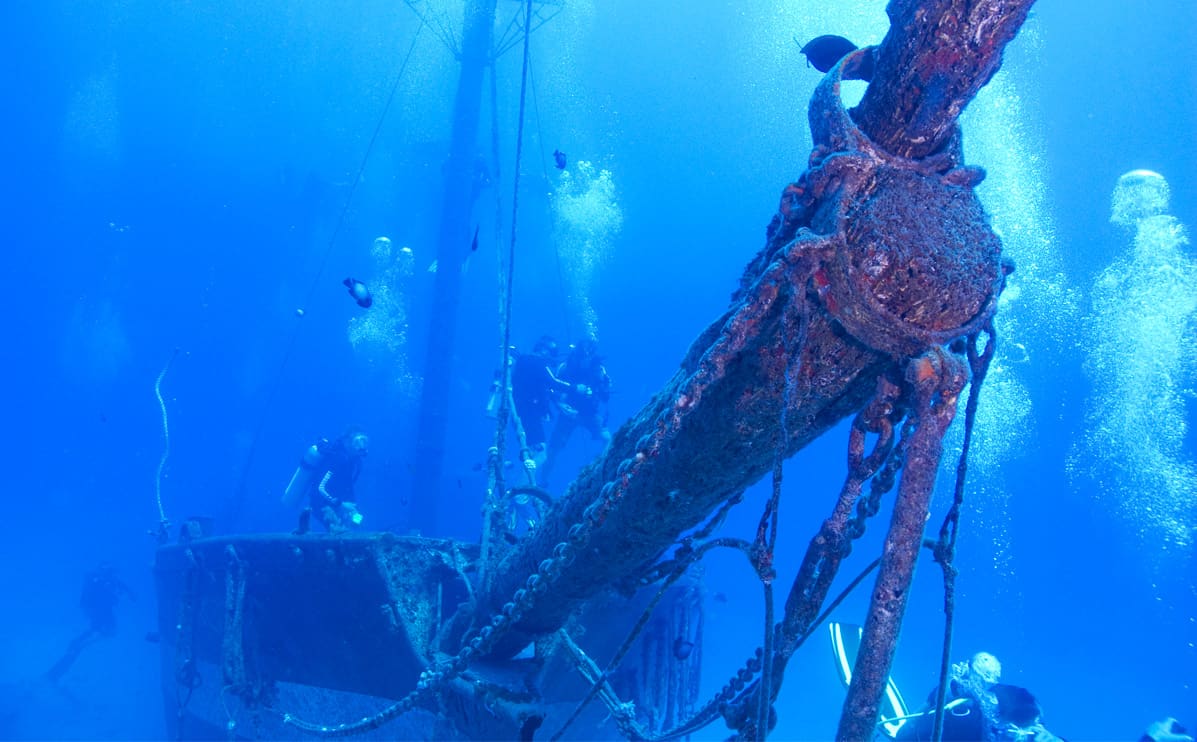Improving Dive Skills On Dry Land- Part Ii
Explore with us, visualizing your next set of dives on Maui, and be better prepared for the journey. In Part I of practicing dive skills on land, there were some interesting tips on navigation, photography and fitness. With the help of PADI, we’ve gathered a few more things to practice on land before your next dive. This time around, we are going to get totally inside your head!
Visualization

Mental imagery can be used to improve your diving. When you repeatedly imagine yourself executing the perfect dive, you condition your neural pathways to do so. It makes an impact on your nervous system because your brain benefits from familiarization. Reflect on past experiences – visualize how you could improve your dive next time. Think about different outcomes of various diving scenarios, and imagine how you would respond to each one. By mentally rehearsing your reactions you’ll build up a mental ‘script’ to help guide you on your real dives.
Visualization takes less effort than the exercise regime we mentioned in Part 1 and it’s easy to fit into your daily routine – 5 minutes at bedtime, commuting to work, even on the plane heading to Maui! While you are at it, you might as well keep this beautiful Maui ocean scene in your mind:
Research
Although technically not a ‘dive skill’, using your dry time to research and expand your diving knowledge will almost certainly improve your time underwater.
Find out everything you can about dive sites you’re planning to dive so that you can navigate and locate points of interest with ease. Of, course on all of our charters you always have a friendly dive guide along pointing out interesting sites along the way.
Here are descriptions and what marine life you are likely to find at Lahaina Diver’s most frequented dive sites.
Molokini Crater

Molokini Crater Charter. Bombed, fished then preserved, Molokini Crater has been a Marine Life Conservation District since the summer of 1977. It is also a bird sanctuary above water. The underwater landscape features some of the most extensive hard coral reefs in Hawaii. What was once a round, volcanic cinder cone is now partially submerged, creating a protective crescent atoll.

With visibility exceeding 100 feet, you’ll encounter a wide variety of tropical fish, including yellow tang, moorish idol, parrot fish, black triggerfish, bluefin trevally and various butterfly fish. A huge whale shark may pass by. Our dive guides will help point out some more elusive creatures such as Hawaiian garden eels, manta rays, white tip reef sharks and moray eels. You might even discover a delicate harlequin shrimp amongst the coral heads or a nudibranch in a crevice.
Backwall Molokini Charter. The exciting Backwall Molokini charter takes you outside the crater, to the dramatic back wall for a drift dive. A towering 200 foot above-water cliff drops to over 300 feet below the surface, creating one of the top wall dives.

Our dive hovers around 80 feet, with a view of the islet wall descending into the deep blue below. Because the backwall is open to the deep ocean, a variety of pelagic marine life might swim by. In addition to schools of fish, it is not unusual to see dolphins, mantas, and sharks. November through April, there is a good chance to hear humpback whales underwater, and experience these gentle giants while going to and from the dive site.
The second drift dive on this charter takes you just inside the crater itself. Molokini Crater has been a Marine Life Conservation District (MLCD) since the summer of 1977 and features the most pristine hard coral reefs in Hawaii. In addition to colorful reef fish- some found nowhere else in the world- you may see graceful rays, octopus, moray eels or white tip reef sharks.
Turtle Reef

Turtle Reef Charter. Just off the coastline of West Maui is a sweeping region filled with sea life called Turtle Reef. Usually, we will pick a center spot near Mala Wharf, where divers are submerged in a world not only teeming with aquatic animals, but underground structures of a sunken pier. Frog fish, white tip reef sharks, nudibranchs and the majestic Green Sea Turtle are all common occurrences on this dive along with a host of fish and other unique creatures.

Depending on weather, we may occasionally pick a different site to the north or south to explore coral gardens and abundant marine life.The many fringing and finger coral reefs, coves and bays that dot the area make it an ideal location for innumerable Green Sea turtle cleaning stations.
Though not unique to Maui, the Green Sea turtle is the only indigenous reptile to Hawaii, and can be consistently seen diving near the sunken Mala Wharf.A fish species you may spot here is a cleaner Wrasse. Turtles line up for their turn to be cleaned by the wrasse at the “shell station.”
Green Sea Turtles are protected by the endangered species act. With this and other species we encourage you to look but don’t touch. Just as a reminder, please don’t closely approach or interact with sea turtles, whales or dolphins. This includes attempting to swim with, pet or touch them.
Wreck Diving

Carthaginian Charter. Step back in time to when Lahaina was the Whaling capital of the Pacific and dive the scurvy decks of an underwater wreck. Just a short boat ride from Lahaina Harbor sits the sunken ship Carthaginian II, at a depth of 97 ft. Scuba Diving and Sport Diver magazines have rated the Carthaginian site as one of the top locations for shipwreck diving.

The complicated rigging work of the second incarnation of the Carthaginian was done at the dock in Lahaina and modeled after the dimensions of the 1870 brig Marie Sophie. After serving many years as a floating museum in Lahaina, the ship was sunk in 2005, continuing as a beloved landmark.
Today the Carthaginian is a base for corals serves as gathering place for ocean life. A semi-penetrable wreck, the hull is a favorite of white tip reef sharks who can often be seen resting inside. Eagle rays and dolphins are sometimes spotted passing by in the blue, while frog fish, eels, starfish and other smaller creatures stay close to the safety of the ship. Atlantis Submarine frequently runs tours that circle the ship, giving lucky divers a chance to wave at their passengers and pose for a photo with a submarine in the back drop.
The second dive of the Carthaginian charter goes to Turtle Reef, so you get two exceptional sites in one outing.
Hammerhead Dive

Hammerhead Charter. Our most adventurous dive crosses the temperamental Paiolo channel for a glimpse of the elusive and beautiful hammerhead shark. Off the island of Molokai is one of the few sites on the planet where one can commonly witness these sharks swimming, often in large groups. This blue water drift dive frequently encounters hammerhead and other sharks, colorful endemic fish and the occasional Hawaiian Monk Seal.

Molokai boasts many beautiful and unique dive sights, including spots frequented by Scalloped Hammerhead sharks. Though aggressive hunters of marine life, hammerheads are not considered dangerous and are normally not aggressive towards humans. Note: hammerheads are a frequently seen, but like with anything in nature, their presence is not guaranteed.
Though the hammerheads are the main attraction, many other kinds of rare and interesting sea life has been spotted during this dive that Lahaina Divers exclusively developed many years ago. Over the years we have spotted tiger sharks, oceanic black tip sharks and even thrasher sharks. Closer to the surface you might spot unicorn fish, pyramid butterfly fish, yellow tangs, long nose butterfly fish, and occasionally a Hawaiian monk seal or two, as well as a host of other sea life.
Others may attempt diving in waters off Molokai, but Lahaina Diver’s large, well equipped rigid hull boats are best for the often-challenging conditions.
Lanai

Lanai Cathedrals Charter. Off the coast of Lanai lies an underwater wonderland like no other. Here you can explore stunning rock formations, rare corals and many endemic species found only in Hawaii. Majestic cathedral-like structures, with lacey holes in the rock and coral above, let sunlight pour into lava tubes, swim throughs and archways.

Its unique topography makes Lanai diving is possibly the most ethereal visually, and an experience that is not to be missed. With over 35 dive sites, many of our customers do this charter more than once.
Explore lava formed caves, swim throughs and abundant marine life. Look for schools of orange cave-dwelling menpachi, bright colored moorish idols and yellow tangs, reef sharks and turtles. Dolphins often accompany the boat on the crossing to Lanai, and it is common to see whales in season.
3 Tank Lanai Charter. Travel to the far side of Lanai for a three-tank drift dive in waters not often seen by others diving Lanai. This charter for experienced divers goes a little farther, away from the more commonly frequented sights of Lanai, to explore places many will never see.

While still taking in the amazing underwater topography off Lanai and abundant reef fish, there is a greater chance of seeing deep water marine life like manta rays and whale sharks on the 3 tank dive.
If your sense of adventure craves blowing bubbles off the beaten path then this series of drift dives will quench its thirst
Plan Ahead
Create a list of sea life you want to spot on your next dive with us on Maui. You can use your logbook as a research tool, noting what you find in a particular dive site. Also, be aware that since COVID-19 restrictions decreased Lahaina Diver’s boats to less than half our capacity, charters book up faster than normal. Make your reservations early– we would hate for you to lose out a great dive excursion, plus, we would miss you!
Apart from practicing your land based dive skills, time on the surface is also a good opportunity to maintain your equipment and start planning your next trip. Please reach out if you have any questions about diving in the waters around Maui!
